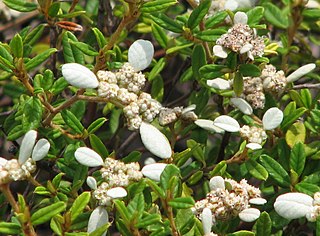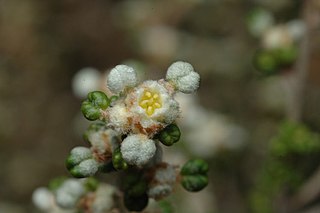
Spyridium globulosum, commonly known as basket bush, is a species of flowering plant in the family Rhamnaceae and is endemic to coastal areas in the south-west of Western Australia. It is a shrub with relatively large leaves and heads of flowers covered with whitish hairs.

Spyridium vexilliferum, commonly known as winged spyridium, or helicopter bush, is a species of flowering plant in the family Rhamnaceae and is endemic to south-eastern Australia. It is a small, low-lying to erect shrub with linear to narrowly elliptic leaves, and dense heads of small white flowers.

Hibbertia vestita, commonly known as hairy guinea-flower, is a species of flowering plant in the family Dilleniaceae and is endemic to eastern Australia. It is a small shrub with foliage covered with simple hairs, and usually has linear leaves, and yellow flowers with 22 to 43 stamens and many staminodes arranged around three hairy carpels.

Hibbertia ericifolia is a species of flowering plant in the family Dilleniaceae and is endemic to south-eastern Australia. It is small, sometimes low-lying to spreading shrub with wiry stems, linear to narrow elliptic leaves, and yellow flowers arranged on the ends of branchlets, with ten to twenty-four stamens arranged around the three carpels.

Asterolasia grandiflora is a species of weak, open shrub or sub-shrub that is endemic to the southwest of Western Australia. It has oblong, elliptical or egg-shaped leaves and pink to mauve flowers arranged in umbels of about three flowers with a thick covering of star-shaped hairs on the back of the petals.

Correa lawrenceana var. lawrenceana is the implicit autonym of Correa lawrenceana and is endemic to Tasmania. It is a shrub with papery, oblong leaves and pale green, narrow cylindrical flowers arranged singly on the ends of branchlets.

Olearia pinifolia is a species of flowering plant in the family Asteraceae and is endemic to Tasmania. It is a shrub with rigid, linear, sharply-pointed leaves and white and yellow, daisy-like inflorescences.
Hibbertia hirsuta is a species of flowering plant in the family Dilleniaceae and is endemic to southern Australia. It is a small, slender, prostrate shrub with sparsely hairy foliage, narrow elliptic leaves and small yellow flowers with a single petal, usually only a single stamen and two carpels.
Olearia hookeri, commonly known as crimsontip daisybush, is a species of flowering plant in the family Asteraceae and is endemic to Tasmania. It is a sticky shrub with small, narrowly linear leaves and white to bluish-purple and yellow, daisy-like inflorescences.
Olearia obcordata is a species of flowering plant in the family Asteraceae and is endemic to Tasmania. It is a shrub that typically grows to a height of less than 3 ft (0.91 m). It usually has wedge-shaped leaves arranged alternately along the branchlets, the narrower end towards the base, with three or five teeth on the ends. The flowers are arranged singly in leaf axils and are few in number with up to six ray florets.

Spyridium bifidum, commonly known as forked spyridium, is a species of flowering plant in the family Rhamnaceae and is endemic to South Australia. It is an erect shrub with densely softly-hairy young stems, wedge-shaped to linear leaves sometimes with a two-lobed tip, and densely woolly heads of white-velvety flowers.

Spyridium cordatum is a species of flowering plant in the family Rhamnaceae and is endemic to the south-west of Western Australia. It is a prostrate, straggling or ascending shrub with leathery, broadly heart-shaped leaves with a notched tip, 2–4 mm (0.079–0.157 in) long with woolly, white or rust-coloured hairs on the lower side. The heads of flowers are 6.5–8.5 mm (0.26–0.33 in) wide with two to four floral leaves at the base. The sepals are up to 1.6 mm (0.063 in) long the petal tube shaggy-hairy with more or less glabrous lobes.

Spyridium gunnii is a species of flowering plant in the family Rhamnaceae and is endemic to Tasmania. It is an upright shrub with more or less glabrous, egg-shaped leaves, the narrower end towards the base, and mostly more than 12 mm (0.47 in) long. The heads of flowers are arranged in cymes surrounded by 2, 3 or more floral leaves. The sepals are about 3 mm (0.12 in) long and woolly-hairy on the outside.

Spyridium lawrencei, commonly known as small-leaf spyridium or small-leaf dustymiller, is a species of flowering plant in the family Rhamnaceae and is endemic to Tasmania. It is an erect, compact or straggling shrub with small, leathery, round to heart-shaped leaves, and dense heads of hairy, cream-coloured flowers.

Spyridium microcephalum is a species of flowering plant in the family Rhamnaceae and is endemic to the south-west of Western Australia. It is a spreading or erect shrub with linear leaves and heads of woolly-hairy flowers.

Cryptandra alpina, commonly known as alpine pearlflower, is a species of flowering plant in the family Rhamnaceae and is endemic to Tasmania. It is a small, prostrate shrub with slender branches, linear leaves, and tube-shaped white flowers arranged singly on the ends of branches.

Spyridium obcordatum, commonly known as creeping spyridium or creeping dustymiller, is a species of flowering plant in the family Rhamnaceae and is endemic to Tasmania. It is a prostrate shrub with heart-shaped leaves, the narrower end towards the base, and clusters of hairy, white flowers.

Spyridium obovatum is a species of flowering plant in the family Rhamnaceae and is endemic to Tasmania. It is an upright shrub that typically grows to a height of 0.9–2.5 m and has egg-shaped leaves, the narrower end towards the base, and about 13 mm (0.51 in) long. Small, compact heads of flowers are arranged on the ends of branchlets, the sepals either cream-coloured or yellow, depending on the variety.

Spyridium oligocephalum is a species of flowering plant in the family Rhamnaceae and is endemic to the south-west of Western Australia. It is a shrub that typically grows to a height of 0.6–1.5 m, its leaves glabrous except when very young. There are large, papery, orange-brown stipules joined in pairs at their bases, at the base of the petiole. The flowers are arranged in head-like, condensed cymes on the ends of branchlets. The sepals are about 1 mm (0.039 in) long and densely covered with hairs 0.3–0.5 mm (0.012–0.020 in) long.

Spyridium spadiceum is a species of flowering plant in the family Rhamnaceae and is endemic to the south of Western Australia. It is an erect or semi-prostrate shrub with narrowly oblong to oval leaves and heads of hairy flowers with brown bracts at the base.

















